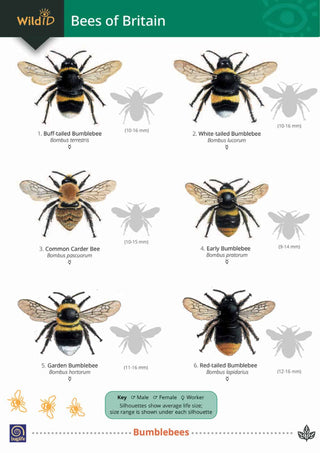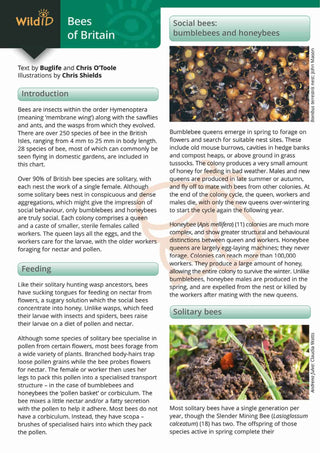FSC Bees of Britain
The FSC Bees Identification Guide features 28 species of bees which can be seen flying in gardens.
The FSC Bee identification chart consists of 8 fold-out pages featuring full-colour illustrations, making the identification of bees much easier to follow. The reverse side includes concise identification notes for each species. This text covers key characters to look out for, plus flight period, habitat and range. Also included in this bee field guide are useful pointers to help distinguish between similar-looking species.
Did you know that there are over 250 species of bees in Britain and Ireland?
Bumblebees and honeybees are social bees, living in in colonies. But 90% of British species are solitary, with each nest the work of a single female. Mining bees excavate nest tunnels and cells in the ground. Cavity-nesting bees (including mason bees and leafcutters) use pre-existing cavities such as hollow plant stems, or a bee hotel. Cuckoo bees have a similar nesting strategy to the cuckoo bird. A female cuckoo bee will seek out the nest of another bee to lay her eggs. The Sharp-tailed Bee is a cuckoo bee frequent in gardens.
FSC Bees of Britain
The FSC Bees Identification Guide features 28 species of bees which can be seen flying in gardens.
The FSC Bee identification chart consists of 8 fold-out pages featuring full-colour illustrations, making the identification of bees much easier to follow. The reverse side includes concise identification notes for each species. This text covers key characters to look out for, plus flight period, habitat and range. Also included in this bee field guide are useful pointers to help distinguish between similar-looking species.
Did you know that there are over 250 species of bees in Britain and Ireland?
Bumblebees and honeybees are social bees, living in in colonies. But 90% of British species are solitary, with each nest the work of a single female. Mining bees excavate nest tunnels and cells in the ground. Cavity-nesting bees (including mason bees and leafcutters) use pre-existing cavities such as hollow plant stems, or a bee hotel. Cuckoo bees have a similar nesting strategy to the cuckoo bird. A female cuckoo bee will seek out the nest of another bee to lay her eggs. The Sharp-tailed Bee is a cuckoo bee frequent in gardens.



